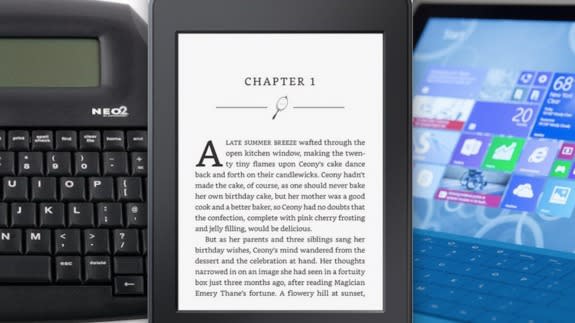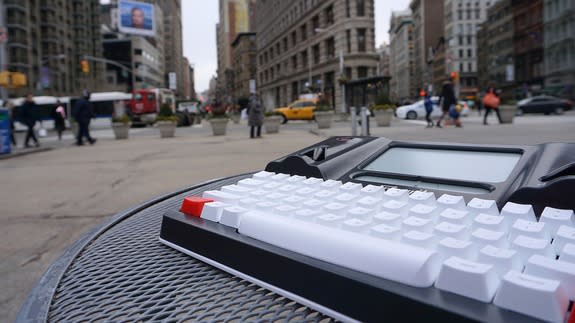The perfect device for writers has yet to be built. Here's what it needs.

The appearance of the Freewrite, a $500 machine that does nothing but cloud-based word processing, was bound to cause howls of protest.
You can read all the arguments against the Freewrite in this skeptical piece by my colleagues Karissa Bell and Christina Warren. Here's the TL;DR: It's too expensive ($500 will buy you a 16GB iPad Air 2, or a couple of 16GB iPad Minis), and it's too hefty (four pounds, the same weight as a fully loaded Macbook).

Image: Astrohaus
And perhaps most damningly, it's ergonomically incorrect. Hunching over this 6-inch e-ink screen all day, trying to read what you just wrote, will give you such a crick in the neck.

Image: Disney
But the very existence of this curious single-purpose gadget, and the fact that it raised $342,000 on Kickstarter — nearly $100,000 more than its target — suggests that there's a crying need for this kind of single-purpose gadget among writers. (I know I'm always looking out for one — or rather, a double-purpose gadget. But we'll get to that.)
It also explains the enduring popularity of the AlphaSmart Neo, a similar single-purpose writing device that only has space for eight files and can only upload to your PC via a clunky old USB cable. The Neo isn't even being manufactured any more, but has gained a cult following online; you can pick one up second-hand on eBay or Amazon for as little as $40.
The purpose of these machines is not being addressed by the existence of cheap iPads; indeed, it is being harmed by them.
"Laptops and iPads are multi-purpose devices loaded with games, social media, work email, funny cat videos, and those birthday photos you still need to edit," wrote the Freewrite's creators on Kickstarter, back when it was lumbered with the even more pretentious name of the Hemingwrite. "Like many of you, when we tried to get down to writing, we quickly found ourselves down a YouTube rabbit hole which we rationalized to ourselves as research. Sound familiar?"
See also: Forget the boring old selfie. Let these 32 authors teach you how to shelfie.
Why yes, it certainly does sound familiar. Writers are invariably brilliant people, if I do say so myself, but procrastination is our kryptonite. The iPad and the web browser are procrastination incarnate: How can the one writing app, or the one tab you're writing in, compete with a screen full of other colorful options? Especially when you're a smart person who can rationalize just about anything on the Internet as research.
Unless you're some kind of superhuman who only keeps one or two apps on your homescreen, or never opens more than a handful of tabs at a time, the user experience deck is stacked against you. Turn on your device and you run a gauntlet of notifications, badges and the colorful icons of other apps, distracting and alluring as a Vegas casino floor.
Really, it's a wonder we get any writing done at all. (That's why the good old-fashioned torture device known as the deadline remains popular; editors, invariably writers themselves, know what it takes to concentrate the mind.)
Design specs for the writer's best friend
The Freewrite is a good faith effort to help you focus, as was the AlphaSmart Neo. But neither quite deliver what a writer needs, and my Neo is currently gathering dust — because as I explain below, a writer needs to read in more than equal measure. For that reason I have made an uneasy peace with writing on iPads and laptops, and run the attention deficit gauntlet every day.
Still, I have had in mind for many years the feature list of my perfect combination writing and reading gadget. Here it is, along with an explanation of why those two functions are so necessary together.
1) Hundreds of hours of battery life. Both the Freewrite and the Neo got this exactly right. (The Neo's rechargeable battery lasts for 700 hours on a single charge, and also runs on AA batteries. The Freewrite is said to last more than 4 weeks on a single charge.)
Because having to lug a charger or battery brick everywhere is a pain, and because while writing takes a lot of mental energy, it doesn't require a lot of electricity. Perhaps a solar-powered e-book cover of the kind just unveiled at Mobile World Congress could provide you with the necessary power. So long wall charger.
2) E-ink screen with backlight. Anyone who has tried reading on a Kindle versus reading on an iPad knows why e-ink rules. You can read it clear as day in direct sunlight; it takes less energy; the backlight isn't so bright that it's going to disturb your partner in bed or keep you awake into the small hours. And speaking of Kindles ...
3) E-books storage. The e-ink Kindle (available in regular, Paperwhite and Voyage) is an indispensable aid to writers, notwithstanding the genuine appeal of physical books. I carry my Paperwhite everywhere and have often wished I could simply write on one, flipping back and forth to my draft in between bursts of reading.
Wouldn't that defeat the idea of a single-purpose device, I hear you ask? Not at all, because deep reading and good writing are inextricably linked. Writers will always find ways to procrastinate, after all, and books count as the most productive procrastination in the world. They are the tools you need to sharpen your mind and become a better writer.
As Stephen King advised in his seminal book On Writing, "The more you read, the less apt you are to make a fool of yourself with your word processor." If you don't have time to read, King said bluntly, you don't have time to write. (He also said that writers learn more from bad books than from good ones; even the trashiest YA novel is going to teach you something about good pacing and structure, by its absence.)
Finally, the act of constantly seeing your words on the exact same e-ink screen in the exact same font and style as the words of a published author would act as powerful subliminal encouragement. It's all just words, this device would tell you. In theory, any human being is capable of wrangling words in the right order, sufficient to arouse powerful reactions in millions of other humans.
4) A smart keyboard cover and a kickstand. What the ultimate writing device needs to borrow from the Microsoft Surface are the two things that tablet got just right: a thin, light, tactile, removable keyboard that doubles as the screen cover, and a slim kickstand so you can view it at a decent angle and you don't get the crick in the neck from craning down at the screen.
It's really the viewing angle that made me reluctantly abandon the AlphaSmart Neo all those years ago, not the screen size. Having fewer lines of text on the screen actually helped me focus on the sentence I was writing, with far greater results. (There are popular apps that go to great lengths to replicate this effect on the large screen.)
Speaking of getting small ...
5) A compact form factor. The smaller this device is, the more places you'll take it. You need to picture yourself clutching it comfortably as you walk down the street to the coffee shop — not large enough that it requires a laptop bag, or that it requires two hands to hold the screen. And not too small that it's a pain to type on.
I've been enjoying the form factor of the iPad Mini with a Logitech keyboard case for this reason (it's in the same ballpark as the Kindle's form factor, too). Then again, I know a lot of writers favor wider keyboards; my fingers are plenty stubby, but they aren't the stubbiest around. Halfway between the Mini and the iPad Air in size, not to mention weight, seems like the sweet spot. Call it a screen size of roughly 8.5 inches.
6) Cloud storage backup of everything you write all the time as often as possible because it's 2016. (And strong encryption for that backup, because it's 2016.) The Freewrite is capable of backing up to multiple cloud services whenever it's on Wi-Fi, but we live in an LTE world.
As Amazon's excellent WhisperSync service has demonstrated, it really doesn't take that much data to download and update pure text files, which are generally measured in kilobytes. For its 3G Kindle models, Amazon eats that data cost as a price of doing business.
For the ideal writing device, I'd be willing to pay an annual fee to keep everything syncing nicely in the background via data service whenever it's strong enough to use with ease. The benefits of never have to worry about the Wi-Fi connection, in terms of extra writing and reading time, would be enormous. (Besides, that Wi-Fi dial on the Freewrite looks like a big unnecessary distraction.)
Make this happen
There are a few tiny features on the nice-to-have list. It almost goes without saying that a device made for reading as well as writing really ought to render italics, bold and underline formatting just as the Kindle does — not in markdown code as the Freewrite does.
If I were really shooting for the moon, I'd say a text-only offline version of Wikipedia would be enormously useful for writers. Such a thing would take up around 11.5 GB of storage — hardly out of the realm of possibility in the modern computing world.
Given the Kindle-like nature of the device, it might make sense that Amazon be the one to make it. Then again, it would be child's play to make a device read the open .mobi format that most digital books, including Kindle books, arrive in.
Get to it, entrepreneurs — there's a whole planet full of distracted writers waiting to shake your hand.

